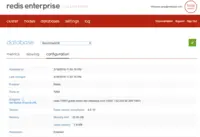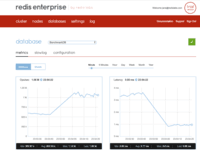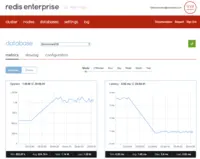Overview
What is Redis™*?
Redis is an open source in-memory data structure server and NoSQL database.
TrustRadius Insights
Best open-source caching database
Set up & forget
Redis is THE solution to all your caching problems
Great in-memory database solution
Redis is a great product offering from Amazon
REDIS great as K/V cache
Redis Review
Redis Solves many application caching problems.
Fast and reliable
Best DB for a gaming company willing to scale overnight
Redis is awesome!
Redis will improve reliability and performance and reduced costs.
Improve performance at a reduced cost
Gets the job done!
Awards
Products that are considered exceptional by their customers based on a variety of criteria win TrustRadius awards. Learn more about the types of TrustRadius awards to make the best purchase decision. More about TrustRadius Awards
Popular Features
- Performance (69)10.0100%
- Scalability (69)9.494%
- Availability (69)9.090%
- Concurrency (68)9.090%
Reviewer Pros & Cons
Pricing
Cloud
$388.00
Entry-level set up fee?
- Setup fee optional
Offerings
- Free Trial
- Free/Freemium Version
- Premium Consulting/Integration Services
Features
NoSQL Databases
NoSQL databases are designed to be used across large distrusted systems. They are notably much more scalable and much faster and handling very large data loads than traditional relational databases.
- 10Performance(69) Ratings
How fast the database performs under data load
- 9Availability(69) Ratings
Availability is the probability that the NoSQL database will be available to preform its function when called upon.
- 9Concurrency(68) Ratings
Concurrency is the ability for multiple processes to access or change shared data simultaneously. The greater the number of concurrent user processes that can execute without blocking each other, the greater the concurrency of the database system.
- 8Security(63) Ratings
Security features include authentication against external security mechanisms liker LDAP, Windows Active Directory, and authorization or privilege management. Some NoSQL databases also support encryption.
- 9.4Scalability(69) Ratings
NoSQL databases are inherently more stable than relational databases and have built-in support for replication and partitioning of data to support scalability.
- 9.9Data model flexibility(62) Ratings
NoSQL databases do not rely on rely on tables, columns, rows, or schemas to organize and retrieve data, but use use more flexible data models to accommodate the large volume and variety of data being generated by modern applications.
- 9.3Deployment model flexibility(62) Ratings
Can be deployed on-premise or in the cloud.
Product Details
- About
- Integrations
- Competitors
- Tech Details
- Downloadables
- FAQs
What is Redis™*?
According to the vendor, Redis is an in-memory multi-model database that supports multiple data structures such as strings, hashes, lists, sets, sorted sets with range queries, bitmaps, hyperloglogs and geospatial indexes with radius queries. Redis has built-in replication, Lua scripting, LRU eviction, transactions and different levels of on-disk persistence, and provides high availability and automatic partitioning with Redis Cluster.
Redis combines in-memory, schema-less design with optimized data structures and versatile modules that adapt to your data needs. The result is an adept, high performance, multi-purpose database that scales easily like a simple key/value data store but delivers sophisticated functionality with great simplicity, according to the vendor.
Redis also enables data persistence and high availability through replication and backups. Redis Enterprise is built from the ground up to serve as a system of record for any application.
*Redis is a trademark of Redis Ltd. Any rights therein are reserved to Redis Ltd. Any use by TrustRadius is for referential purposes only and does not indicate any sponsorship, endorsement or affiliation between Redis and TrustRadius.
Redis™* Features
NoSQL Databases Features
- Supported: Performance
- Supported: Availability
- Supported: Concurrency
- Supported: Security
- Supported: Scalability
- Supported: Data model flexibility
- Supported: Deployment model flexibility
Additional Features
- Supported: Integrated modules
- Supported: Active-Passive Geo Distribution
- Supported: Cluster Architecture
- Supported: Linear Scaling
- Supported: Durability
- Supported: Backup and Disaster Recovery
- Supported: Reliability
Redis™* Screenshots
Redis™* Video
Redis™* Integrations
- Apache Spark
- Red Hat OpenShift
- CData
- Pivotal Cloud Foundry
Redis™* Competitors
Redis™* Technical Details
| Deployment Types | On-premise, Software as a Service (SaaS), Cloud, or Web-Based |
|---|---|
| Operating Systems | Windows, Linux, Mac |
| Mobile Application | Apple iOS, Android, Windows Phone, Blackberry, Mobile Web |
| Supported Countries | Global |
| Supported Languages | https://redis.io/clients |
Redis™* Downloadables
Frequently Asked Questions
Comparisons
Compare with
Reviews and Ratings
(224)Community Insights
- Business Problems Solved
- Recommendations
Redis has proven itself to be an invaluable tool in a wide range of use cases. Users have found Redis to be exceptional as an efficient caching solution, allowing for the distribution of data and storage of web sessions. This capability has led to significant improvements in performance and reliability, making it a go-to choice for many backend development teams. Additionally, Redis's versatility as a NoSQL key-based database store has made it a preferred option for organizations working alongside other databases like PostgreSQL and Memcache. Its ease of use, stability, and reliability have made it a popular choice across multiple departments within organizations.
Furthermore, Redis has been leveraged in various R&D projects to experiment with its implementation in different modules. Starting with cache management, users have been able to extend its usage to address specific project needs effectively. In these experiments, Redis has served as a traditional in-memory key store warehouse for cache systems with a vast number of items, resulting in substantial latency savings. Its ability to manage distributed queues efficiently has also made Redis an excellent choice for tasks that require multiple worker nodes to subscribe and complete tasks. The flexibility Redis offers by enabling users to store sets of object-based information and lists further improves performance through set operations.
In addition to these use cases, Redis has become synonymous with simplicity and speed when it comes to basic yet fast key-value storage solutions. It has been extensively adopted in organizations, including game studios, where it is used for storing user data, session data, game data, and indexing information. For example, Redis Enterprise has been utilized to support backend systems for casual games by providing sub-millisecond response times and facilitating clustering, sharding, backups, and monitoring.
Moreover, customers have found Redis instrumental in addressing various challenges such as big data processing, handling temporal data, managing session state, and even as a caching service in microservices environments. Its ability to provide data consistency, concurrency management, and high-speed operations has proven invaluable. Additionally, Redis has been a reliable tool for caching solutions in e-commerce storefronts and data visualization applications. Users have reported reduced server load and improved performance as a result of implementing Redis as a cache.
Redis has also found success as a buffer cache, allowing for faster data retrieval and improved overall database performance. Its role in processing queues, calling APIs, and supporting vital organizational workflows has been recognized by customers who rely on its stability and speed. Furthermore, users have implemented Redis across various domains to manage user timelines, build notification systems, and implement microservices architecture
Users recommend the following for Redis:
Consider other cache options before choosing Redis. It is advisable to try out other caching solutions before jumping to Redis, even though it is a great tool for highly distributed caching.
Understand the purpose of Redis in your implementation. It is important to have a clear understanding of how Redis will be used in your specific application. Don't assume that it will work straight out of the box. Evaluate data structures and choose a model that allows for faster query times.
Use Redis for specific use cases. Redis shines in certain areas such as synchronizing states across instances and handling user sessions with Node.js. It can also be a good alternative for relational data when speed is of utmost importance. However, users caution against abusing Redis and recommend using it in a reasonable way.
Overall, users believe that Redis is a valuable tool for fast reliable storage and caching, particularly for enterprise applications. However, they also advise considering other key-value stores depending on the specific use case at hand.
Attribute Ratings
Reviews
(1-25 of 33)Blazing performance, excellent stability, and really nothing to dislike make Redis a must look at solution
- Cache speed
- Support for high volume of transactions with elegant handling of data sets
- Ease of use - well structured and easy to implement
- Price per shard is a bit high but over all there are no issues worth mentioning
- I've heard some wishing it supported complex queries but this is asking the solution to support operations it wasn't intended for
- Big data manipulation
- Temporal data index structures
- Distributed solutions
- Publish/Subscribe model based solutions
Best open-source caching database
- A modern key-value store in-memory database.
- Redis [is thorough] and details user documentation.
- Data distribution on a multi-tenant cluster is easy and reliable.
- It lacks support for datatypes that are available on other products.
- Making it work with Celery is a bit hard and sometime it's not reliable.
- Lacks better UI like other systems.
The ramp up and integration was quite easy.
Redis handles automatic failover internally, so no crashes provides high availability.
On the fly scaling scale to more/less cores and memory as and when needed.
Great in-memory database solution
We also used it as session storage manager for some other projects.
- It's fast for key value hashes operations.
- Lua Scripting extension is really powerful.
- Single-threaded.
Data binding as we can use its key value architecture to store data from different sources under the same key so they will be automatically matched. And with now previous data structure we can extend for example hashes horizontally.
It may be costly to use it as persistent data storage.
REDIS great as K/V cache
- Quick key lookups.
- Distribution of data is easy and reliable.
- Almost HA.
- HA automatic failover for master and promoting slave on own.
- Doesn't handle 1M r/s sadly.
- Cross DC replication not so great.
Redis Solves many application caching problems.
- Application data caching.
- Session data caching.
- Managing cache misses better.
Fast and reliable
- Caching
- Message broker
- Different OSs
- Great reliability and great fail over capabilities
- Easy to set up, implement and deploy
- Can scale as you grow
- Backups to AWS S3 are supported and are very easy to set up
- Better UI interface for less technical support personnel
- Wish Reids had a Chat support option
- Better documentation in a wiki format
Gets the job done!
- Ease of use and set-up.
- Clustering and sharding.
- Automated backups to remote storage (S3).
- The documentation grows quite fast (200+ commands), perhaps they should have a most-used ranking.
- Redis modules (Bloom, JSON, Search) are great, but only one can be active at a time.
Get a cache server on steroids with Redis and get rid of those Memcached instances
The main problem it solves for us is to need to have a high-performance cache that also provides data persistence so we can restart instances and deploy new ones without losing data in the middle. This is very important for us because of the problem we're tackling. In the case of auth tokens, we don't want to make all users log in again after we restart an instance because the memory got cleared. The same applies for the sync flags that our processes depend on to complete.
- High performance. Redis is FAST, really fast.
- Data persistence. Having this feature was the main reason we chose Redis over Memcached.
- Clustering. Distributing data between multiple instances is easy to do with Redis.
- Data types. It isn't normal to have native data types supported on cache servers, but Redis covers many areas for this use case.
- The data type collections aren't extensive and can fall short for some needs.
- Single-threaded. Redis doesn't support multi-threading, so it won't benefit from multi-core CPUs. Instead, you need to deploy several single-core instances to scale horizontally. While this is a design decision, it may be a downside on some infrastructures.
- Lack of UI. A visual UI can be a downer for some users.
It's usually compared to Memcached, and in terms of performance I think they're very similar, and for some critical applications, Memcached may be a better option. But the feature-rich characteristics of Redis will position it in a more competitive place against many applications.
Redis is the best cache database on the market
- Very scalable.
- High performance.
- Easy to use.
- Management tool could be better.
- Books in Spanish.
The Redis Imperative
- Redis provides the ability to score data quickly.
- Redis provides the ability to distribute this info in a fast manner.
- Redis provides an alternative method for data retrieval which lessens the load on the database access.
- Greater emphasis on Pub/Sub capabilities more in line with Kafka.
Redis is the backbone of our ephemeral data, from web page caching to session storage.
- Key value storage
- Session and Cookie management
- Frontend caching
- Third-party library support sometimes lags
- Weak type support
- Everything is in memory, so you need lots of RAM
Super fast and easy to integrate
The great thing about this is also that each cluster can be running a different version of our application allowing us to maintain a high level of robustness for our larger enterprise customers, while also allowing us to deploy frequently to other clusters that want the bleeding edge. With Redis, being able to determine the right cluster for the right request happens blazing fast.
- FAST LOOKUPS. First and foremost, this is the bread and butter of Redis. It is our go-to for any highly performant lookups.
- SCALE OUT. Helps build distributed applications that need to share data across geographies.
- Better GUI clients. At the time of adoption, the choices for UI based clients were poor. Such tools are necessary for tier 1 support personnel who may not be entirely technically savvy.
Redis Review
- Storing geolocations - Redis has built-in geolocation storage capabilities, thus saving us the time of developing the logic ourselves.
- Serving fast info for real-time apps - To anyone who works with real-time applications, fast information is the basis of good user experiences.
- I think the documentation could improve. It's not always clear, especially for engineers that are new on Redis.
- Redislabs admin interface could use a tune-up, maybe being more informative and with a better UI.
- I think the main cons I see in Redis could be that it may be a bit too obscure to new users.
Simple yet powerful datastore
- Simple, fast Keystore.
- Reliable.
- Efficient storage.
- Better handling if capacity is reached - sometimes it just crashes our server.
Reduced costs
- Speeds up database searches.
- Cloud-based without the need for on-prem.
- High availability.
- Support needs to be better, with chat support as an option.
- Training material for new hire dev-ops.
- Wiki-type documentation.
Redis is great when you use it correctly.
- Fast key value store
- Serializable concurrent usage (by virtue of being single-threaded)
- Wide library support
- Failover is terrifying and its safety guarantees are misleading
- Large sets (> 500k entries) have noticeable performance degradation on what is advertised to be a O(1) query pattern
- Hardware costs are high
Redis and its CSAT
- Binary key-value store support
- Simple data structures
- Very well documented
- Nested use of data structures
- GUI tool in better shape
- More courses on Redis
Redis : Effective cache management solution
- Cache management: Redis is the best solution out there for cache management. It out marked Memcache in latency. Redis gives better flexibility when comes to data storage techniques.
- For example: Instead of storing objects as serialized strings, we can use a Redis Hash to store an object's fields and values and manage them using a single key.
- Replication: Redis has the best build in replication feature.
- For example, It allows slave Redis instances to be exact copies of master instances. The slave will automatically reconnect to the master every time the link breaks and will attempt to be an exact copy of it regardless of what happens to the master.
- Pub/Sub- It's Publish & Subscribe system of Redis. Where Publish broadcast content to all its subscribers simultaneously. There are various use cases of Pub/Sub. Developers are using it for triggering scripts based on Pub/Sub events. There are various chat ecosystems built on the Pub/Sub module.
- Redis is super fast but it comes with a cost. Whole dataset resides in RAM. So it can be costly as primary memory is more costly, then secondary ones.
- Persistence issues: To achieve it, Redis uses a memory dump to create a persistence snapshot, that's cool. But it requires some Linux Kernel tweaking to avoid performance degradation while the Redis server process is forking. This further causes latency.
- Master-slave structure side effect: Master-slave architecture comes with its own side effects. Please note that there will be only one master with multiple slaves for replication. All writing goes to the master, which creates more load on the master node. So, when the master goes down, the whole architecture does.
Redis analysis
- Atomic counters
- Cache colocated with other services that require low latencies
- Automatic memory management
- CLI could be improved
- Configuration management
- Replication and snarfing
Redis: the best cache store you can get!
- High-speed access for a database where the size is generally well-known.
- If you display real-time stock prices, you can use Redis to rapidly get the latest stock price by its key and get it displayed to the user.
- Support for data structures such as scalars, sets, hashes, and lists.
- Persistence can impact performance since Redis will use memory dump to create snapshots used for persistence.
- Redis supports only basic security options. Redis doesn't provide any access control.
- There is no internal full-text search support and it is difficult to model relationships using Redis.
Performant In-Memory Database
- Quick and Easy Setup
- Fast Performance
- Does its job well!
- Setting up a cluster in Redis is a bit confusing and hard for the first time.
Redis: More than just cache
- Simple Key Value storage
- Easy interface compared to other databases
- Reliable performance characteristics
- Redis needs better distributed support. I know this is not the point, but a distributed Redis with some CAP tradeoffs would be useful
- Redis should be more clear on its pooling capabilities. Should you use a pool or just use a single connection?
- It would be nice if Redis had a better CLI
If you need something that can be written and read by multiple services, that is as fast as possible, use Redis. The simplicity is its biggest strength, and making it more complex will just ruin the product.
Redis Labs is great!
- Fast.
- Reliable.
- Regarding Redis Labs, the UI is not intuitive.
- Redis Labs needs an API so I can automate tasks programmatically.
Redis Review
- Response time - the time taken to store or retrieve something from Redis is minuscule compared to most of the alternatives that we are aware of.
- Value for the money - every time we offload data storage to Redis it saves us money, compared to using something like MongoDB or AWS.
- Better documentation.

















